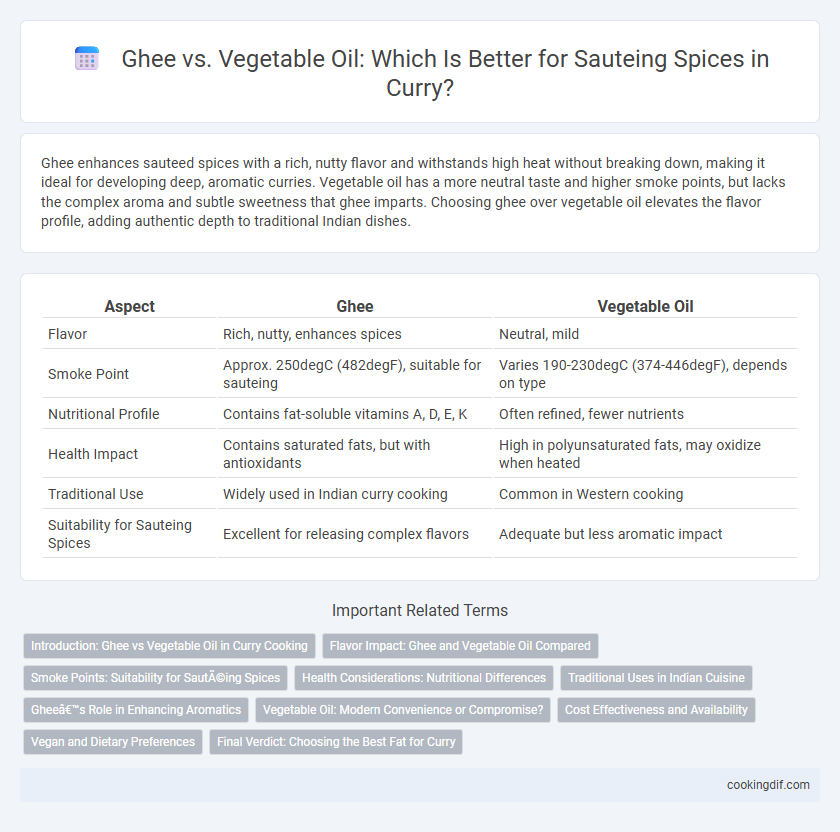Ghee enhances sauteed spices with a rich, nutty flavor and withstands high heat without breaking down, making it ideal for developing deep, aromatic curries. Vegetable oil has a more neutral taste and higher smoke points, but lacks the complex aroma and subtle sweetness that ghee imparts. Choosing ghee over vegetable oil elevates the flavor profile, adding authentic depth to traditional Indian dishes.
Table of Comparison
| Aspect | Ghee | Vegetable Oil |
|---|---|---|
| Flavor | Rich, nutty, enhances spices | Neutral, mild |
| Smoke Point | Approx. 250degC (482degF), suitable for sauteing | Varies 190-230degC (374-446degF), depends on type |
| Nutritional Profile | Contains fat-soluble vitamins A, D, E, K | Often refined, fewer nutrients |
| Health Impact | Contains saturated fats, but with antioxidants | High in polyunsaturated fats, may oxidize when heated |
| Traditional Use | Widely used in Indian curry cooking | Common in Western cooking |
| Suitability for Sauteing Spices | Excellent for releasing complex flavors | Adequate but less aromatic impact |
Introduction: Ghee vs Vegetable Oil in Curry Cooking
Ghee, rich in saturated fats and fat-soluble vitamins like A, D, E, and K, offers a distinctive nutty flavor that enhances the aromatic profile of curry spices during sauteing. Vegetable oils such as canola or sunflower provide a neutral taste with higher smoke points, making them suitable for high-temperature cooking but less impactful on flavor depth. Choosing ghee over vegetable oil in curry preparation intensifies the complexity and authenticity of traditional Indian dishes while contributing beneficial fat-soluble nutrients.
Flavor Impact: Ghee and Vegetable Oil Compared
Ghee imparts a rich, nutty aroma and deepens the flavor profile of sauteed spices, enhancing the complexity of curry dishes. Vegetable oil has a neutral taste, allowing the natural spice characteristics to shine without altering the flavor significantly. Using ghee transforms the curry's texture and aroma, whereas vegetable oil maintains a lighter, more straightforward spice flavor.
Smoke Points: Suitability for Sautéing Spices
Ghee, with a smoke point around 485degF (252degC), is highly suitable for sauteing spices as it prevents burning and preserves flavor integrity. Vegetable oils like canola or sunflower generally have lower smoke points, ranging from 400degF to 450degF (204degC to 232degC), which may cause spices to burn faster. The higher smoke point of ghee makes it preferable for the high-heat cooking involved in spice sauteing, enhancing aroma without producing harmful compounds.
Health Considerations: Nutritional Differences
Ghee contains healthy fats like butyrate and conjugated linoleic acid, which support digestion and anti-inflammatory effects, whereas vegetable oil often has higher levels of omega-6 fatty acids that can promote inflammation if consumed excessively. Ghee is rich in fat-soluble vitamins A, D, E, and K, enhancing nutrient absorption during sauteing spices in curry. Vegetable oils may undergo refining processes that reduce nutrient content and introduce unhealthy trans fats, making ghee a more nutrient-dense option for cooking.
Traditional Uses in Indian Cuisine
Ghee, clarified butter, has been traditionally used in Indian cuisine for sauteing spices due to its rich, nutty flavor and high smoke point, which enhances the aroma and depth of curries. Vegetable oil, though more neutral in flavor and widely used in modern cooking for its affordability and availability, lacks the distinctive taste imparted by ghee. The choice between ghee and vegetable oil significantly influences the authenticity and flavor profile of traditional Indian dishes.
Ghee’s Role in Enhancing Aromatics
Ghee, rich in clarified butterfat, elevates the aromatic profile of sauteed spices by releasing complex, nutty flavors that vegetable oils lack. Its high smoke point ensures spices such as cumin, cardamom, and cloves bloom without burning, intensifying the curry's depth and warmth. Using ghee as a cooking medium imparts a traditional, authentic richness pivotal to classic curry preparations.
Vegetable Oil: Modern Convenience or Compromise?
Vegetable oil offers a neutral flavor and high smoke point, making it a convenient choice for sauteing spices in curry preparation, especially in modern kitchens. However, this convenience may come at the expense of the rich, aromatic depth that ghee imparts, which is essential for authentic curry flavors. While vegetable oil simplifies cooking, it often lacks the nuanced complexity and traditional health benefits associated with ghee's fatty acids and antioxidants.
Cost Effectiveness and Availability
Ghee offers rich flavor and high smoke point, making it ideal for sauteing spices in curries, but its higher cost and limited availability can be a drawback compared to vegetable oil. Vegetable oil is significantly more affordable and widely accessible, providing a neutral base that allows spice flavors to shine without overpowering them. For budget-conscious cooking, vegetable oil often proves more cost-effective while still supporting authentic curry preparation.
Vegan and Dietary Preferences
Ghee offers a rich, nutty flavor ideal for authentic curry dishes but is unsuitable for vegan diets due to its dairy origin. Vegetable oils, such as coconut or mustard oil, provide a plant-based alternative that aligns with vegan and lactose-free dietary preferences while maintaining high smoke points for effective spice sauteing. Choosing the right oil impacts both the curry's flavor profile and adherence to dietary restrictions.
Final Verdict: Choosing the Best Fat for Curry
Ghee offers a rich, nutty flavor and high smoke point ideal for sauteing spices in curry, enhancing aroma and depth. Vegetable oil, while neutral and cost-effective, lacks the complex taste essential for authentic curry richness. For best results, ghee is the preferred fat, providing superior flavor and heat stability in traditional curry preparation.
Ghee vs vegetable oil for sautéing spices Infographic

 cookingdif.com
cookingdif.com